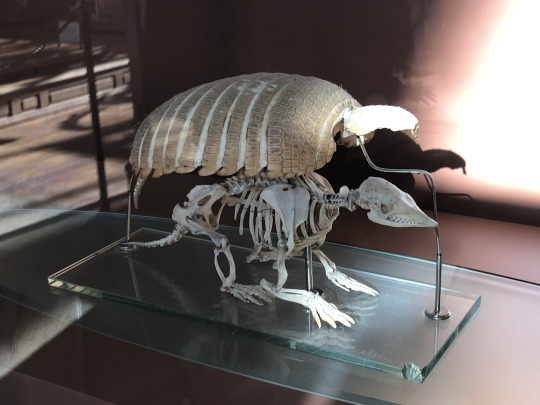#xenarthra
Text

Great Ant-Eater by Cuthbert Edmund Swan. From Wild Beasts of the World, Vol. Two. Written by Frank Finn, published in 1909.
Internet Archive
271 notes
·
View notes
Text
Spectember 2023 #05: Shiny Mammal
Someone who identified themself only as "Hanna" requested a "mammal that's shiny and iridescent like some insects and spiders":

Lustrophractus hannae is a relative of modern hairy armadillos that has adapted for a semiaquatic lifestyle.
About 40cm long (~16"), its unusually shiny carapace originally evolved thanks to its ancestors' burrowing habits. Much like golden moles and some snakes, these armadillos' scutes and hairs developed microridges that reduced friction and repelled dirt particles, with the side effect of becoming strikingly iridescent – and, conveniently, also rather water repellent, enabling Lustrophractus' lineage to take up aquatic omnivorous foraging habits.
The iridescence also serves a defensive function, using a bright flash of color to startle and confuse predators.
#spectember#spectember 2023#speculative evolution#armadillo#xenarthra#mammal#art#science illustration
295 notes
·
View notes
Photo


A young 9 banded armadillo (Dasypus novemcinctus) I captured at work today. Released unharmed after brief examination. Since these guys are one of my favorite native mammals I will celebrate by posting Fun Armadillo Facts™ .
1. Nine-banded armadillos were unheard of in the United States until the late 19th century, when they crossed the Rio-Grande naturally and were introduced to Florida by humans. Their range has expanded rapidly and they now occupy much of the southern US, and are still spreading.
2. Every nine-banded armadillo you see, at one point in its life, had three identical siblings. The species almost invariably produces quadruplets!
3. They are one of the only animals other than humans to be susceptible to leprosy. With a low core temperature and a long lifespan they are perfect for the bacteria to propagate, and actually suffer it systemically rather than on mainly peripheral tissues the way humans do. You are unlikely to get leprosy from the average armadillo, however.
4. Unlike the smaller three-banded armadillo, the nine-banded cannot roll into a ball. Its methods of escape involve either a surprising rapid run, attempting to dig down to where only its carapace is exposed, or, and this is why so many are hit by cars, leaping 3+ vertical feet in order to startle predators. In the words of zefrank, this is precisely the wrong defense to survive a charging honda, regrettably.
5. They can be litter box trained much like a cat!
6.They once had gigantic prehistoric relatives including Doedicurus and Glyptotherium. Large herbivores reaching the size of small cars. I wish so badly that they remained alive so I could ride one.
I hope you enjoyed these Fun Armadillo Facts™
455 notes
·
View notes
Photo

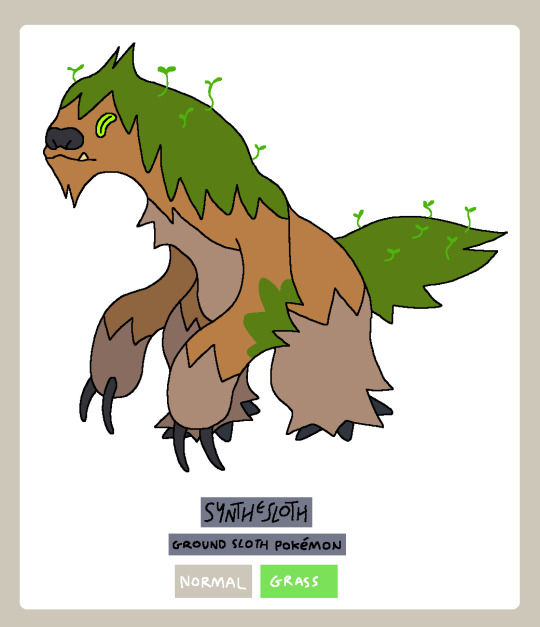

#070 - Foleander
#071 - Synthesloth
#072 - Xenarthere
(redesigns)
#fakemon#pokemon#normal type#grass type#sloth#ground sloth#two toed sloth#megatherium#xenarthra#megafauna
179 notes
·
View notes
Text
Kraglievichia
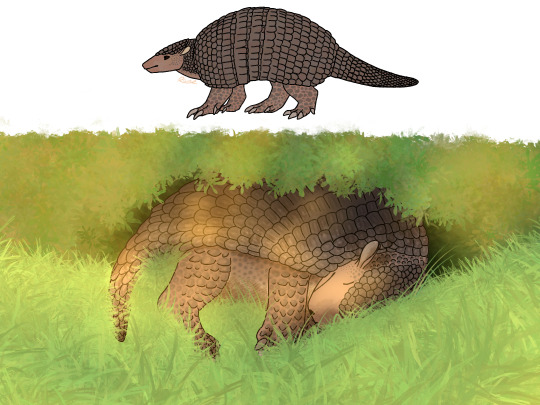
Kraglievichia was a genus of cingulate mammal from the Late Miocene to Early Pliocene periods. Its type species is K. paranense. Its second known species is K. carinatum. The known specimens were found in Argentina and Uruguay. Though initially described in 1883, Kraglievichia was not properly named until 1927.
Its autapomorphy from similar relatives is its distinct osteoderm ornamentation, which consists of significantly deep longitudinal depressions with a longitudinal central elevation. It is the most conspicuously ornamented pampatheriid known currently.
The known specimens of Kraglievichia consist of osteoderms, a left femur, and a well-preserved skull without any teeth. Due to their extreme similarity, Kraglievichia is regarded as the sister taxon to Scirrotherium, the genus that K. carinatum was originally assigned to. It was hypothesized that Holmesina evolved from Kraglievichia, but due to the fact there are no known immediate South American basal forms of Holmesina, this is unlikely. A third species, "K." floridanus, was named in 1976, but this was later found to be a species of Holmesina instead.
Citations: The 1927 description seems entirely lost, at least online; if you happen to have access to this paper please let me know. 1883 description (page 66 of pdf) as Chlamydotherium; "Scirrotherium" carinatum description; "S." carinatum reassignment.
Wikipedia article: here
#mammal#mammalia#paleoart#paleontology#artwork#original art#human artist#kraglievichia#pampatheriidae#cingulata#xenarthra#obscure fossil animals#obscure fossil mammals#obscure fossil tetrapods
11 notes
·
View notes
Text

Ground sloth doodles. I apologize for any inaccuracies.
#megatherium#i think this is megatherium? correct me if I’m wrong#ground sloth#xenarthra#mammal#paleoart#digital doodle#digital doodles#im too lazy to color this sorry
8 notes
·
View notes
Text


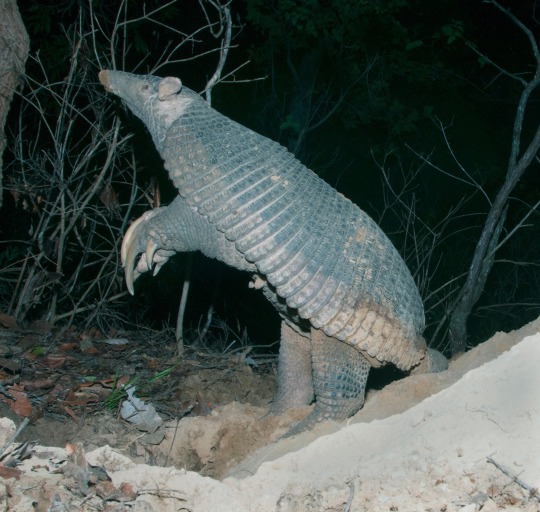

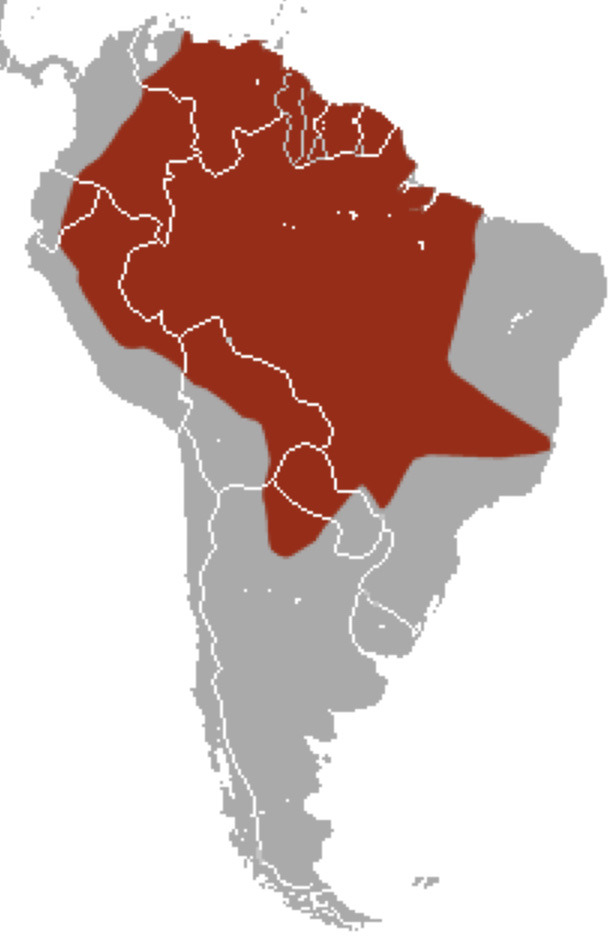
Giant armadillo
Priodontes maximus
Family Chlamyphoridae, order Cingulata, superorder Xenarthra
Also known as the tatu-canastra, tatou, ocarro, and tatú carreta.
They prefer to eat termites and ants and will often consume the population of an entire termite mound. They also sometimes eat worms, larvae, spiders, snakes, carrion, and plants.
They are the largest extant (meaning not extinct) species of armadillo, usually weighing 18.7–32.5 kg (41–72 lb). There has been a wild specimen weighing 54 kg (119 lb) and a captive one weighing 80 kg (180 lb).
They are solitary and nocturnal. They spend the daytime in burrows.
Their burrows are very large, openings average at 43 cm (17 in) wide and typically face west.
These animals have not been studied much in the wild, but it has been discovered that many animals use their burrows. Dozens of animals, including the rare short eared dog, were observed using the same armadillo burrow in one day. They’re like, the construction workers of their area.
This animal is classified as vulnerable.
@jackalspine @fifiibibii
9 notes
·
View notes
Text

Drawtober Day 30- Mummy. This thing should be my mascot. It's 2 of my favorite things combined; a silky anteater and a mummy. Anteater mummy probably has some magic powers too, like maybe they can summon an army of undead ants to do their bidding.
#drawtober#my art#anteaters#anteater#silky anteater#silky anteaters#xenarthrans#xenarthra#pilosa#mummies#halloween#monsters
2 notes
·
View notes
Text

Pampatherium
Pampatherium — вимерлий рід неповнозубих (Xenarthra), що жив в Америці в плейстоцені. Деякі види вимерли прямо на межі плейстоцену і голоцену.
Повний текст на сайті "Вимерлий світ":
https://extinctworld.in.ua/pampatherium/
#pampatherium#paleoart#armadillo#xenarthra#america#pleistocene#usa#holocene#art#paleontology#prehistoric#prehistory#animals#fossils#daily#палеоарт#палеонтологія#ukraine#ukrainian#українська мова#арт#україна#тварини#animal art#extinct#illustration#creatures#мова#наука#scientific
7 notes
·
View notes
Text
Petite teen light skin masturbating Left behind at a house soiree in
Indian Desi Bhabi Fucked in car full Sex Video
Italian fag swallowing cock
Youngest gay porn tube and arab teen boys sex galleries first time An
Indian Bigg boobs Bhabhi
Hot Black Angelika striptease and solo session
Tittyfucking ebony MILF sucks POV cock
Sexy Harlot Jolee Love Seduces Hung Cab Driver
PORNFIDELITY Dakota Skye Receives A Facial From James Deen
hot lesbian babes finger and eat each other until they cum
#self-furnished#preexpress#fence-straddling#aristogenics#inefficience#uplimber#bolter-down#electronographic#gagwriter#caraipi#genethliacally#antidynastical#proxeny#gong's#gunpowder#Onchocerca#substitutionally#Xenarthra#luz#developed
0 notes
Text
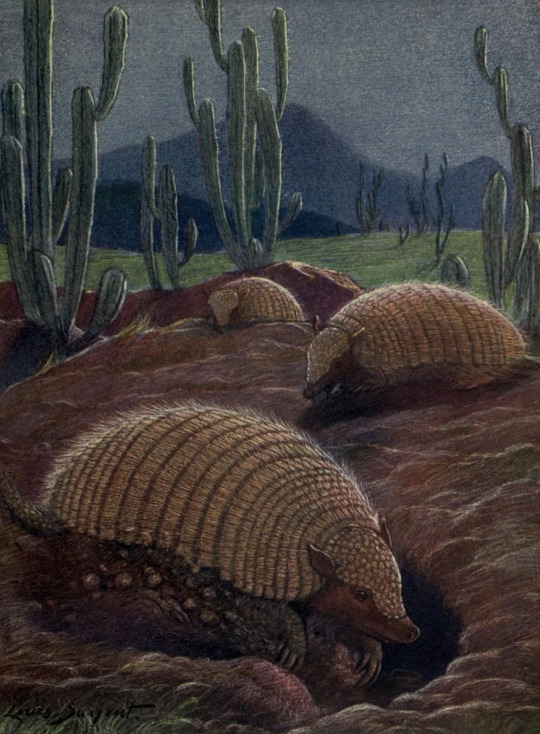
Hairy Armadillos by Louis A. Sargent. From Wild Beasts of the World, Vol. Two. Written by Frank Finn, published in 1909.
Internet Archive
289 notes
·
View notes
Text
So the Preliminary SVP Schedule got released
For those unfamiliar, SVP = Society of Vertebrate Paleontology
usually when paleontologists say "SVP" they mean specifically the conference that SVP hosts each year, one of the biggest events for the "spends their lives studying old bones" people each year
each day has six sessions - three in the morning, three in the afternoon - and they're packed with talks. like, if you want to see talks in two different concurrent sessions, you gotta run around like a maniac
anyways
Wednesday Morning has Sauropods & Ornithischians, Early Mammals & Carnivorans, and then Fishes & Amphibians as three different sessions (all of these are groups of three going forward)
Wednesday afternoon has Dinosaur Soft Tissues, Ungulates, and Marine Reptiles
Thursday Morning has Romer Prize (fancy student talks), Birds, and Preparators' Session
Thursday afternoon has Theropod Flight Origins, Mammal Paleoecology, and Sauropsids
Friday morning has Euarchontoglires & Xenarthra, Archosaurs, and Methods & Paleohistology
Friday afternoon has Actinopterygians, Crocodylomorphs & Turtles, and Paleoecology & Paleoclimatology
Saturday morning has Theropods I, Afrotheria & Mammal Macroevolution, and Synapsids
and Saturday afternoon has Theropods II, Marine Mammals & Bats, and Squamates
The fact that Theropods get four separate focused sessions while Ornithischians and Sauropods are smushed into one is... well, I'm laughing my head off at Theropod bias right now
would you like theropods? Or more theropods? How about some THEROPODS
77 notes
·
View notes
Text
Okay I don't want to stay with mammals for much longer so I'm gonna go through the rest of them here
There are 22 distinct groups of mammals, I've already covered three of them (Carnivora and the even and odd-toed ungulates).
Going through the remaining 19:
There are four groups of marsupials, but that doesn't matter because Rahi-wise there is only one species, the Fusa, a kangaroo. The Kikanalo might also count, but see my ungulate post for that ramble.
There are two groups of Xenarthra (armadillos, sloths, and anteaters) but there are no rahi equivalents at all.
Monotremes (echidnas and platypuses) have no representation either.
Same with Sirenia (manatees and dugongs), Lagomorphs (rabbits), Scandentia (tree shrews), Macroscelidea (elephant shrews), Erinaceidae (hedgehogs), and Afrosoricida (tenrecs and some other miscellaneous small African mammals).
Soricomorpha (shrews and moles) has one representative, the Archives Mole.
Pachyderms likewise also only have one rep, the Hapaka.
Cetaceans only have two reps, the Razor Whale and the Stinger Whale. There is a unique whale rahi in the 2003 console game, but much like with the unique fox rahi, I don't know if I can consider it canon given the nature of the game and how drastically different many canon rahi appear in it.
Chiroptera has three reps, the Cliff Screecher, the Ice Bat, and the unnamed bat rahi from the cancelled pc game and various other 01 promo renders.
There are three primates, the Brakas, a monkey, and two apes, the Lava ape and the Spiny Stone Ape. Much like with the Kavinika, I have some questions regarding if the Spiny Stone Ape is actually an ape, given that it has a tail and frankly, kind of looks like a dinosaur, but that's a discussion for another day.
Lastly, the rodents, of which there are quite a lot. There's the Gafna, the Ice Vermin, the Kinloka, the Kuma-Nui, the Lava Rat, the Stone Rat, and the Wolf Rat from the cancelled pc game. The Kuma-Nui and Wolf Rat are especially interesting considering that the former is really fucking huge, and the later engages in some interesting specevo, being a species of one group filling in the role of a species belonging to a different group.
There, that's every mammalian analogue rahi charted
19 notes
·
View notes
Note
apparently there used to be aquatic sloths, mountain sloths, and burrowing sloths too, as well as african-elephant-sized ones
i'm kinda underwhelmed at the sloths we have today
That semiaquatic sloth was preyed upon by macroraptorial sperm whales.
While the giant burrowing sloths could dig through solid rock and made tunnels you could stand in, many of which are still around today.
Apparently some also had osteoderms. Which technically isn’t that weird since they’re in the same group as armadillos (Xenarthra), but it still feels so weird for a mammal to have osteoderms.
But modern sloths, particularly three toed, also have incredibly weird adaptations themselves, such as:
Having curled muscles in their limbs that give them more strength (pennation)
Being very impact resistant
Sloth body temperature is usually the same as their surroundings, but if it gets too hot they actually depress their metabolism like a hibernating animal, but unlike them they don’t actually shut down organs and can do it very quickly for short periods of time
Having a four chambered stomach
Three toed sloths have 9 neck vertebrae, which is unusual because mammals can’t have more than 7 neck vertebrae because it fucks with their respiration, so three toed sloths are the only exception
It can take 50 days for a sloth to fully digest a single leaf
Three toed sloths sometimes eat as little as 17 grams of food a day, which is around 3 leaves
Sloth fur is a micro ecosystem that they cultivate thanks to weirdly craggy hair cuticles, with a species of algae and moth that only lives in their hair
Modern sloths may not look like much on the outside, but on the inside they’re positively freaky
42 notes
·
View notes
Text
WHAT FORM WOULD YOUR DAEMON TAKE?

xenarthra
ㅤYour daemon would take the form of a xenarthra! Those who have xenarthra daemons are introverted and truly unusual people who don't stress easily. They often have their heads in the clouds and like to go through life casually, avoiding situations that would cause conflict or too much responsibility.
specifically, a sloth
ㅤYour daemon would take the form of a sloth! You are an independent but easygoing individual with an unparalleled sense of patience. More so than others with xenartha daemons, those with sloths are calm and forgiving people, but are rather detached from others and don't mind wandering in and out of others' lives. They're not ambitious or competitive, and overall enjoy maintaining a calm and stable life.
tagged by:ㅤ@bluefeathrs ofc, ty ♡!!
#❥ 𝐌𝐈𝐍𝐉𝐎𝐎𝐍 、dash game#i don't usually post more than one of these things a day but GOD i can't not throw this one out tonight too#the way i laUGHED when the result was sloth omfgggg#absolutely 100% called tf out#and actually so fucking accurate though holy shit the whole thing fits him to a t
4 notes
·
View notes
